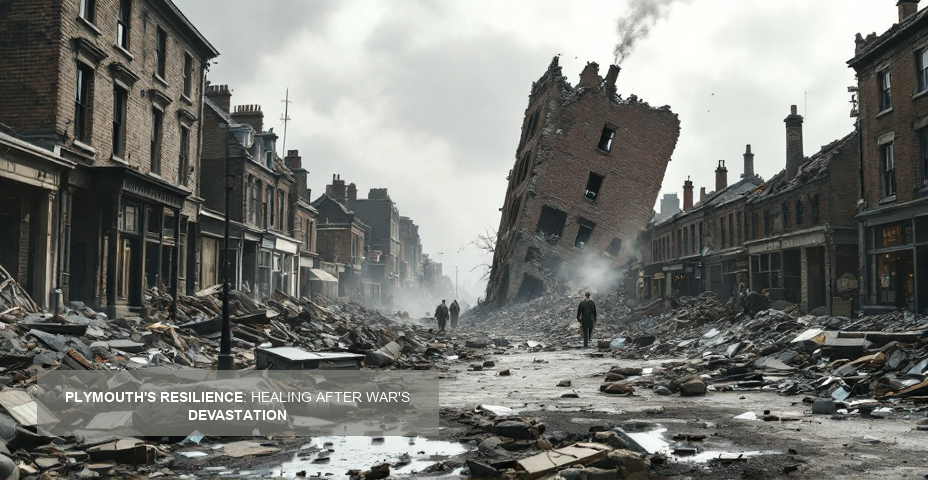Plymouth, with its strategic naval base and dockyards, was a prime target during World War 2. Located on the south coast of Devon, this port city played a significant role in Britain's maritime operations, making it particularly vulnerable to German air raids. From 1940 to 1944, Plymouth endured some of the most intense bombing campaigns of any British city outside London, fundamentally altering its physical landscape and the lives of its residents.
The devastation inflicted upon Plymouth was extraordinary in both scale and impact. The city centre was almost completely destroyed, with historic buildings, businesses, and thousands of homes reduced to rubble. These attacks, known locally as the Plymouth Blitz, forever changed the face of this ancient maritime city. What followed was one of the most ambitious urban reconstruction projects in British history, transforming Plymouth from a bomb-damaged shell into a modern city with a distinctive post-war identity that continues to shape its character today.
The Plymouth Blitz: German Bombing Campaigns
Plymouth became a prime target for German bombing during World War 2 due to its significant naval importance. The city housed Devonport Dockyard, one of Britain's largest naval bases, making it strategically valuable to the German Luftwaffe. Between 1940 and 1944, Plymouth endured 59 bombing attacks as part of the German campaign to cripple British naval power and maritime capabilities.
The German military strategy focused on destroying not only the naval infrastructure but also the surrounding city to disrupt operations and damage morale. The dockyards, naval buildings, and shipbuilding facilities were primary targets, but as bombing raids intensified, civilian areas became increasingly affected. This approach aligned with the broader German strategy of targeting British port cities to weaken the nation's maritime strength and war effort.
The March-April 1941 bombing raids
The most devastating period for Plymouth came during what is now known as the Plymouth Blitz of March-April 1941. The heaviest attacks occurred across several nights in late March and early April, with particularly severe bombing on the nights of 20-21 March, 21-22 April, and 28-29 April. During these raids, hundreds of bombers dropped thousands of incendiary and high-explosive bombs across the city.
These concentrated attacks resulted in widespread destruction throughout Plymouth. The city centre was virtually flattened, with shopping districts, historic buildings, and residential areas reduced to rubble. The March-April bombing campaign claimed approximately 1,000 civilian lives and left thousands more injured or homeless. The intensity of these raids made this period one of the most devastating in Plymouth's long history.
Types of bombs used and attack patterns
The German Luftwaffe employed a calculated bombing strategy against Plymouth, typically beginning raids with incendiary bombs to create fires that would guide subsequent waves of bombers. These incendiary devices were followed by high-explosive bombs weighing up to 1,000 kg, designed to cause maximum structural damage. The combination proved devastatingly effective against Plymouth's densely packed buildings.
Bombing raids generally followed predictable patterns, with attacks beginning after dark and continuing until the early hours of the morning. German bombers would approach from the sea to avoid early detection by radar. The Luftwaffe also employed pathfinder aircraft that would drop flares to illuminate targets for the main bomber force. This systematic approach to bombing contributed significantly to the extensive damage Plymouth suffered throughout the war years.
Damage Assessment: Plymouth's Wartime Destruction
The human cost of the bombing raids on Plymouth was devastating. Over 1,100 civilians lost their lives during the attacks, with thousands more suffering injuries of varying severity. These casualties occurred primarily during the intense bombing campaign known as the Plymouth Blitz, when the German Luftwaffe targeted this important naval city.
The attacks forced many Plymouth residents from their homes, creating a significant displacement crisis. With approximately 3,754 houses completely destroyed and a further 18,398 seriously damaged, many families had no choice but to evacuate or seek temporary accommodation. This mass displacement altered the social fabric of Plymouth and created lasting trauma for those who experienced the raids firsthand.
Destruction of historical buildings and landmarks
Plymouth's architectural heritage suffered tremendous damage during the war. Major landmarks including the Guildhall and St Andrew's Church were gutted by fire, leaving only shells of these once-magnificent structures. The historic city centre, with its Tudor, Jacobean, and Georgian buildings, was particularly hard hit.
Other significant buildings damaged or destroyed included the Royal Hotel, St Andrew's Church, Charles Church, and numerous other churches, schools, and public buildings. The loss of these structures represented not just physical damage but the erasure of centuries of Plymouth history and cultural identity.
Impact on infrastructure and daily life
Beyond buildings, Plymouth's essential infrastructure suffered severe disruption. Water mains, gas lines, electricity networks, and transportation routes were repeatedly damaged, making daily life extremely difficult for remaining residents. Shopping areas and business districts were decimated, affecting employment and access to necessities.
The city's port facilities, vital to both military operations and civilian supply chains, were targeted repeatedly. This damage to infrastructure compounded the hardships faced by Plymouth residents, who endured rationing, blackouts, and the constant threat of air raids throughout the war years.
The Plan for Plymouth: Post-War Reconstruction
Even as the bombs continued to fall, forward-thinking urban planners were already envisioning how Plymouth might rise from the ashes. The 'Plan for Plymouth' was published in 1943, spearheaded by Professor Patrick Abercrombie and James Paton Watson, the City Engineer. This comprehensive blueprint for rebuilding aimed to transform the devastated city into a modern urban centre.
The plan proposed a complete redesign of the city centre with wider boulevards, dedicated shopping areas, and clear zoning for residential, commercial, and industrial sectors. Rather than simply rebuilding what was lost, the planners saw an opportunity to address pre-war problems of overcrowding and poor sanitation while creating a more functional city layout.
New Architectural Styles and Urban Planning
The reconstruction of Plymouth embraced modernist architecture, which represented a dramatic departure from the historical buildings that once defined the city. Clean lines, concrete facades, and functional designs replaced the ornate Victorian and Georgian structures that had been reduced to rubble during the Blitz.
The new Plymouth city centre featured wide, pedestrian-friendly streets arranged in a grid pattern, with Royal Parade serving as the main thoroughfare. Shopping areas were concentrated along Armada Way, creating a clear north-south axis linking the railway station with the waterfront. This rational, ordered approach to urban planning reflected mid-20th century ideals about how cities should function.
Rebuilding Key Civic Structures and Infrastructure
Priority was given to rebuilding essential civic buildings and infrastructure. The Guildhall, though badly damaged, was restored with its original facade but modernised interiors. New public buildings included the Civic Centre, completed in 1962, which consolidated municipal offices into a single prominent structure.
The reconstruction also addressed housing needs with new residential areas developed on the outskirts of the city. Transport infrastructure was improved with wider roads to accommodate increasing motor traffic. While many lamented the loss of Plymouth's historical character, the rebuilding effort created a distinctly modern city that reflected post-war optimism and faith in urban planning.
Plymouth Transformed: The Legacy of Post-War Changes
The Plymouth that emerged after World War II was fundamentally different from the city that existed before the bombing campaigns. The post-war reconstruction, guided by the ambitious "Plan for Plymouth" developed by architect Patrick Abercrombie, created a more ordered, spacious city centre with wide boulevards and modern buildings. This new layout replaced the narrow, winding medieval streets that had characterised the pre-war city for centuries.
The rebuilt city centre featured distinctive limestone buildings and a unified architectural style that gave Plymouth a cohesive post-war identity. Royal Parade became the new main thoroughfare, designed to accommodate increasing motor traffic, while the shopping precincts were planned to separate pedestrians from vehicles—a forward-thinking concept for the 1950s that reflected how dramatically the urban landscape had changed.
Preservation efforts for remaining historical
Despite the extensive destruction, efforts were made to preserve or reconstruct some of Plymouth's most significant historical buildings. The Guildhall, though severely damaged by incendiary bombs, was carefully restored rather than demolished, maintaining its distinctive façade while the interior was redesigned. This preservation represented a conscious decision to maintain links with the city's past despite the overwhelming urge for modernisation.
Several churches, including St Andrew's Church and Charles Church, received different treatment. While St Andrew's was restored to its former glory, Charles Church was deliberately left as a shell—preserved as a permanent memorial to the civilian victims of the Plymouth Blitz. These preservation choices reflect the complex balance between remembrance and renewal that faced post-war planners.
Modern Plymouth and its wartime heritage
Today, the wartime experience remains an integral part of Plymouth's heritage and identity. The Plymouth history museum offers extensive exhibitions documenting the bombing and reconstruction, while walking tours highlight both visible war damage and post-war architecture. The Plymouth Barbican, which survived much of the bombing, provides visitors with a glimpse of how parts of the city appeared before the war.
Memorials throughout the city commemorate the civilian and military losses, while Plymouth heritage initiatives continue to document and preserve Plymouth history photos and personal accounts from the wartime period. The changes in Plymouth post World War 2 remain evident in the city's layout, architecture, and cultural identity—a permanent reminder of both the devastating impact of the war and the remarkable resilience shown in rebuilding this historic naval city.
Summary of The Enduring Impact of World War 2 on Plymouth
World War 2 permanently altered Plymouth in ways that continue to shape the city today. The devastating bombing campaigns by the German Luftwaffe transformed Plymouth from a historic naval port to a city with a distinctive post-war appearance. The destruction of approximately 3,700 homes and 1,000 businesses not only changed the physical landscape but also the social fabric of the community.
While the Plymouth Plan created a more modern, organised city centre, it also erased centuries of heritage. Yet through this devastation emerged a resilient community spirit that remains part of Plymouth's identity. The war memorials, preserved ruins, and rebuilt landmarks serve as constant reminders of both the tremendous loss and remarkable recovery that define Plymouth's wartime experience and continue to influence its development as a British city with a profound connection to its World War 2 heritage.







